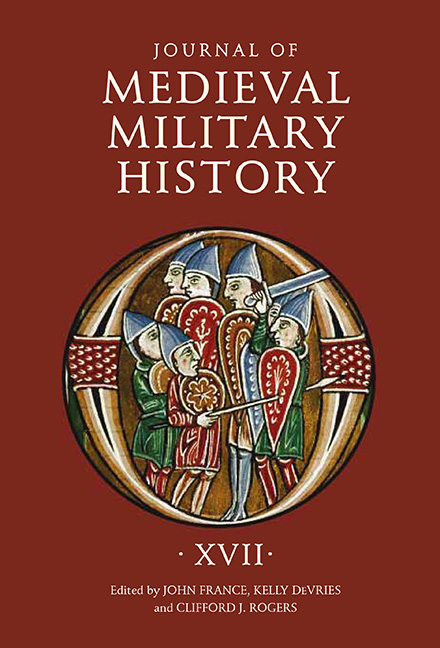Book contents
- Frontmatter
- Contents
- List of Illustrations
- 1 Baktash the Forgotten: The Battle of Tell Bashir (1108) and the Saljuq Civil Wars
- 2 The External Fortifications of ʿAtlit Castle, the Only Unconquered Crusader Stronghold in the Holy Land
- 3 Holy Warriors, Worldly War: Military Religious Orders and Secular Conflict
- 4 Elionor of Sicily: A Mediterranean Queen’s Two Lives of Family, Administration, Diplomacy, and War
- 5 Wives, Mistresses, Lovers, and Daughters: The Fortunes of War for Royal Women in Late Fourteenth Century Castile. OR: A Gender Limitation on Writing History from Chronicles
- 6 The Lance in the Fifteenth Century: How French Cavalry Overcame the English Defensive System in the Latter Part of the Hundred Years War
- 7 Supplying the Army, 1498: The Florentine Campaign in the Pisan Countryside
- 8 Fencing, Martial Sport, and Urban Culture in Early Modern Germany: The Case of Strasbourg
- 9 Note: An Army on the March and in Camp – Guillaume Guiart’s Branche des royaus lingnages
- List of Contributors
- Journal of Medieval Military History 1477–545X
8 - Fencing, Martial Sport, and Urban Culture in Early Modern Germany: The Case of Strasbourg
Published online by Cambridge University Press: 12 June 2021
- Frontmatter
- Contents
- List of Illustrations
- 1 Baktash the Forgotten: The Battle of Tell Bashir (1108) and the Saljuq Civil Wars
- 2 The External Fortifications of ʿAtlit Castle, the Only Unconquered Crusader Stronghold in the Holy Land
- 3 Holy Warriors, Worldly War: Military Religious Orders and Secular Conflict
- 4 Elionor of Sicily: A Mediterranean Queen’s Two Lives of Family, Administration, Diplomacy, and War
- 5 Wives, Mistresses, Lovers, and Daughters: The Fortunes of War for Royal Women in Late Fourteenth Century Castile. OR: A Gender Limitation on Writing History from Chronicles
- 6 The Lance in the Fifteenth Century: How French Cavalry Overcame the English Defensive System in the Latter Part of the Hundred Years War
- 7 Supplying the Army, 1498: The Florentine Campaign in the Pisan Countryside
- 8 Fencing, Martial Sport, and Urban Culture in Early Modern Germany: The Case of Strasbourg
- 9 Note: An Army on the March and in Camp – Guillaume Guiart’s Branche des royaus lingnages
- List of Contributors
- Journal of Medieval Military History 1477–545X
Summary
Despite the preeminence of gunpowder weapons in late medieval and early modern Strasbourg, fencing formed an important subculture in this city as in the rest of the Holy Roman Empire. In an age where owning and bearing arms was associated with enfranchisement and citizenship, tournaments using the longsword and other weapons formed a means for increasingly proletarianized journeymen to assert their masculinity and social standing. These activities were tightly controlled by the city council, which also left a rich trove of documentation. Further, the rise of fencing societies in the sixteenth century, which were often split between Protestant and Catholic lines, as well as a pan-Germanic literature of fencing that formed communities through referencing a common history, show that the history of fencing is relevant to the history of the Holy Roman Empire as a whole and the formation of a German ethnostate.
Situated on the Rhine frontier between the Holy Roman Empire and the Kingdom of France, the city of Strasbourg was both strategically and economically important. As with other free Imperial cities, a large part of Strasbourg’s military pride was wrapped up in its use of ranged weapons – first arbalests, then gunpowder weapons. The practice of such weapons was promoted by the city government: Strasbourgeois arbalesters and gunners took part in numerous battles and sieges, and even after the decline of the civic militia and the rise of standing armies in the early sixteenth century, the self-perception remained, and the manufacture of firearms was a major industry. In a 1588 military parade, only 275 of 880 footmen did not carry firearms – 80 came with pikes (Langspiess), 70 with halberds (Hellenpart), 65 with two-handed swords (Schlachtschwert), and 60 with boar spears (Federspiess). When Louis XIV made his triumphal entry into the city in 1681, he was greeted by a salute from 300 guns.
This was reflected in the official sporting culture of the city by well-publicized shooting competitions, such as a 1576 match with Zurich commemorated in verse by the Strasbourg literatus Johann Fischart (c. 1545–91; see Fig. 1) and in art by his frequent collaborator Tobias Stimmer (1539–84), in which a pot of porridge cooked in the Swiss city was still warm 19 hours later when the Zurich team carrying it arrived by boat in Strasbourg.
- Type
- Chapter
- Information
- Journal of Medieval Military HistoryVolume XVII, pp. 237 - 258Publisher: Boydell & BrewerPrint publication year: 2019



